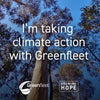Smart HULA - Partnering with Greenfleet to reduce carbon footprint
Smart HULA is Going Carbon Neutral
Another reason to enjoy working out with Smart HULA!
Us here at Smart HULA identifies the carbon emissions associated with each delivery and want to minimise the environmental impact that is caused by our business. As a first step towards that we are using;
- 100% recyclable outer packaging
- 100% biodegradable polymailer bags
- carbon neutral transport system via AusPost
Another initiative we have taken upon to take these efforts one step further is to partner with Greenfleet to further offset CO2 per each delivery. So now you can be at peace of mind, that your order has no carbon footprint on our mother Earth.

Greenfleet
Greenfleet is a leading not-for-profit environmental organisation on a mission to protect our climate by restoring our forests. As Australia’s first carbon offset provider, since 1997, Greenfleet has planted 9.6 million trees, creating more than 500 biodiverse forests in Australia and New Zealand, which are protected for up to 100 years and have offset more than 3.5 million tonnes of CO2-e. Greenfleet works with over 400 organisations, many who have been offsetting their annual carbon emissions for over 10 years. Our partners include Telstra, University of Melbourne, Bendigo Bank, CANVA, Grill’d Healthy Burgers, Taronga Zoo, and Sydney Opera House.
Greenfleet uses Full Carbon Accounting Model (FullCAM), developed by CSIRO and approved by the Australian Department of the Environment to measure the carbon uptake of our forest at each planting site. Our forests are legally protected on-title for up to 100 years from land clearing, harvesting and house construction, even if the land is sold. Established native forests are resilient and can survive dry periods, fire, and pests. If natural disasters such as fire, floods and drought, or browsing by animals such as rabbits or deer damage the trees that we have planted for you, we will replace them or replant in another area.
Greenfleet always plants a range of species that will provide the right foundation for a complex forest to emerge in each bioregion. By including locally adaptive species in our planting, we ensure a resilient forest will thrive. We return regularly to each planting during the establishment phase to check the health and growth rate of the trees and look for signs of emerging forest complexity. After planting, we use aerial photography to track the development of the new forest. If a forest needs support, we will replace or replant in another location to ensure the complete absorption of each offset. You can see more detail of this process in their FAQs.

